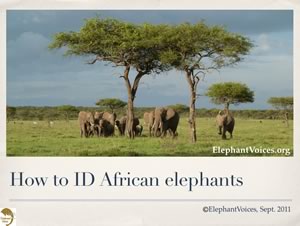Mara Elephants Who's Who & Whereabouts
 Identifying elephants isn't difficult, but it requires using powers of observation and it takes a bit of practice. There are many different characteristics that you can use to identify an elephant: sex; body size; shape; length and configuration of the tusks; size and shape of the ears; ear venation patterns; notches, tears, holes in the ears. ElephantVoices has developed eight educational modules explaining how to read and understand these characteristics, also used in the Mara Elephants Who's Who database.
Identifying elephants isn't difficult, but it requires using powers of observation and it takes a bit of practice. There are many different characteristics that you can use to identify an elephant: sex; body size; shape; length and configuration of the tusks; size and shape of the ears; ear venation patterns; notches, tears, holes in the ears. ElephantVoices has developed eight educational modules explaining how to read and understand these characteristics, also used in the Mara Elephants Who's Who database.
You should start by determining whether the elephant you are trying to identify is male or female, and will get help from How to sex African Elephants.
Just like people, some elephants are long and lanky, while others are short and round. Indeed, elephants come in all shapes and sizes, and once you are experienced it is possible to use body shape to ID an elephant. Learn more about a few of the more obvious features by clicking on the screenshot to the right, or on one of the links to photos below. You will then start a slideshow. The caption shown is equal to respective text on this page. You can go through slide by slide - or let it run through automatically. Learn more about elephants - enjoy!
What to look for when using body characteristics to identify African elephants
- Many elephants in many populations (like in the Mara) bear old abscesses from arrow and spear wounds that show up as "bumps/lumps" on their body. These old wounds make very useful identifying marks. Photo G1
- Some elephants are "permanently lame". Photo G2
- A few elephants have "radio collars." Photo G3


